Covered Destinations: New Delhi -> Roorkee -> Panipat -> Chandigarh -> Sirhind -> Ajmer -> Jaipur -> Agra -> Fatehpur Sikri
Duration: Sufi Tour India 10 Days / 9 Nights
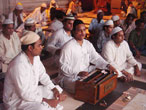
Sufism, the Path of Love, cannot be learnt from books, it must be experienced and felt. This is why we would like to give you the opportunity to visit Dargahs (shrines of the Sufi Saints), as these are the places where the souls of the Sufi Saints are always present, being a direct channel to GOD...
The ultimate goal of a sufi is, to meet his Beloved (GOD) here in this world and to merge with HIM. Sufi practices, like meditation and zikr and listening to qawwali music can guide us to the vision of the Beloved in nature and in everything… "Wherever I turn, I see Your Face..."
We would like to share our personal experiences by taking you on these trips. We believe that while reading many sufi books, you learn nothing until you have really felt it. It is only then, that you will know...
DAY 1 |
Delhi Arrival at Delhi: Meet with India Sufi Tour Guide at Airport and transfer to the hotel. Delhi is popularly known as the 'blessed threshold of the 22 saints'. For centuries saints and their disciples have either camped or resided in Delhi. Owing to the presence of Sufis and mystics, Delhi at one time was referred to as Hazrat-e-Dilli and Khurd-e-Mecca or the little Mecca. The story of Delhi and its contact with Sufism goes back to the 12th century. At the Sufi shrines, lamps are lit, holy scriptures are recited, poor are fed and prayers of a thousand pilgrims answered. Sufism flourished in India and acquired a unique identity. Shrines of famous Sufis and their disciples can be found in other parts of the country as well. After rest in the morning and lunch Start the tour by paying homage to Qutubddin Bakhtiar Kaki, Delhi's first Sufi saint. Kaki was designated to Delhi by his spiritual teacher Khwaja Moinuddin Chisti of Ajmer. It is believed that the city of Delhi cannot be destroyed as long as Kaki shrine exists. Listen to a short recital of Qul, said to be the beginning of the popular Qawwali or songs in praise of a God and the prophet. 
Later visit the Qutub Complex, an array of medieval monuments in the vicinity of the dargah that has been recognized by UNESCO as World Heritage site. Of these, the 239 feet high Qutub Minar is the most important. Adjoining the soaring minaret is the Quwwat-ul-Islam mosque' the first mosque built in Delhi. Built in 12th centuries, the two monuments were added and expanded upon by later Islamic rulers. In the early evening visit the Dargah of Hazrat Nizamuddin. Hazrat Nizamuddin Auliya dominated the spiritual landscape of Delhi for nearly 60 years. At his khanqah or shrine, his close disciple and famed poet Amir Khusrau excelled. The beginnings of Sufiana Qawwali (group singing) are attributed to him. Visit Mirza Ghalib's, the poet laureate of Delhi's grave and hear two translated poems composed by the famous Delhi poet. Overnight at the hotel. |
DAY 2 |
Delhi 
Morning: Tour of Old Delhi, 300-year-old once a walled city built by the Mughal emperor Shah Jehan in 1648 as his capital. The focus of the city is the magnificent Red Fort and the Jami Mosque built of red sandstone. Visit Jama Masjid, perched high on a hillock, the most elegant mosque in India. In between and around the two focal points of the 17th century city is a thriving modern city. Visit the grave of Sarmad Faqir, an Armenian Jewish trader who traveled all over West Asia and later embraced Islam. Faqir Sarmad is known for his poetry and inspirational words. He was beheaded and buried opposite the Eastern or the royal gate of the Jama Masjid. Afternoon visit UNESCO recognized World Heritage Site of Humayun's Tomb-Commissioned by Humayun's widow in 1562. It was designed by Persian architects. The tomb on a high plinth is set in the center of a garden. The garden is based on the principles of the Persian char bagh pattern, first of its kind in South Asia. Later visit Safdurjung Tomb and the Lodi Garden. Safdarjung Tomb is a garden tomb that was built in mid 18th century. The tomb is one of the best preserved specimens of late Mughal architecture. Safdarjung was a powerful minister during the reign of Mughal Emperor Muhammad Shah. Lodi Garden is one of Delhi's green lungs. The area was once a graveyard of 15th and 16th century Delhi rulers. It was landscaped by the British to be used as picnic gardens. In 1968, the gardens were spruced and re-landscaped to their present form. Overnight at the hotel |
DAY 3 |
Delhi -> Roorkee 165 Kms. 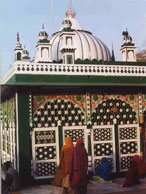
After breakfast leave by coach for same day visit to Kaliyar Sharif located in the town of Roorkee, approximately 165 km north of Delhi. After lunch visit the shrine of Kaliyar Sharif Piran Kaliyar, also known as Kaliyar Sharif, is the burial place of a Sufi saint named Ali'uddin Ali Ahmad Sabir. The tomb is set in a small village, whose only attraction is the presence of the saint, for whose blessings the faithful still seek. The Dargah Kaliyar Sharif is now in existence for about 800 years. Return to Delhi. Overnight at the hotel. |
DAY 4 |
Delhi - Panipat 97 Kms. Panipat - Chandigarh 170 Kms. 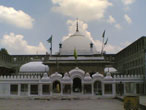
After breakfast leave by coach for a trip to Panipat. Visit the dargah of one of the most renowned Sufi saints, Bu Ali Shah Qalandar. Bu Ali Shah Qalandar was born in the 15th century as Sheikh Sharfuddin. After an Ibadat of 36 years by standing in water inthe nearby town of Karnal, the saint achieved the status of 'Bu-Ali-Shah Qalandar'. Later proceed to Chandigarh. Chandigarh was planned and designed by the famous French architect Le Corbusier whose minimalist structures continue to attract architects from around the world.
Le Corbusier envisioned Chandigarh as a city organized strictly by function. There are residential sectors, an industrial sector, a sector for colleges and research institutions, a central commercial and office area, and a spacious capitol complex against a mountain backdrop. A lush green valley running through the center gives the city its 'lungs.' The city continues to function today along the orderly lines of its creator. Overnight at the hotel. |
DAY 5 |
Chandigarh - Sirhind 60 Kms. Chandigarh - Delhi 250 Kms. 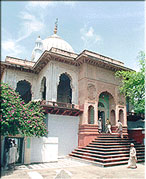
In the morning after breakfast leave for Sirhind, known for a highly revered rauza. This rauza or mausoleum commemorates burial place of Hazrat Mujadid-alf-Saani Sheikh Ahmed Farooqi, who lived during the reigns of the Mughal Emperors Akbar and Jehangir from 1563 to 1634. The tomb of the Shah Zaman, one of the Kings of Afghanistan indicates that the Rauza was once considered a propitious burial place of high and mighty. Return to Chandigarh after visit. Lunch at Chandigarh for lunch and later leave for Delhi. Overnight at the hotel. |
DAY 6 |
Delhi -> Ajmer 325 Kms. 
Early morning depart by train for Ajmer Sharif to visit the shrine of Khwaja Moinuddin Chisti. The shrine commands a very special place in the Sufi world. Also referred to as Gharib Nawaz, Moinuddin Chisti is called the 'Saint of India'. He is the founder of the Chistiya order of Sufism in India. The central principles that became characteristics Chistiyya order are based on his teachings and practices. They lay stress on renunciation of material goods; strict regime of self-discipline and personal prayer; participation in Sama (music, dance and ritualistic activities) as a legitimate means to spiritual transformation. Chistis believe in humanity. They are known for generosity to others, particularly, through sharing of food and tolerance and respect for religious differences. Many important historical figures and contemporary political figures have visited this shrine including H.H Dalai Lama. Make a second visit in the evening for prayers. Overnight at the hotel. |
DAY 7 |
Ajmer -> Jaipur 135 Kms. 
After breakfast at hotel, depart by coach for hotel in Jaipur. After lunch visit Amber Fort followed by an orientation tour of Jaipur. Built by Maharaja Sawai Jai Singh in the early 18th century, the city of Jaipur is amongst the first of India's planned cities. Known as the Pink City, Jaipur still beats in its fairy tale Palaces; rugged fortresses perched on barren hills and broad avenues. Jaipur has a timeless appeal in its colorful bazaars and is famous for traditional jewellery, miniature paintings and blue pottery. Jaipur is also the capital of modern Indian state of Rajasthan, the abode of Rajputs. Amber Fort is a classic Rajasthani Fort and palace. The fort may look rough and austere from the outside, but the interiors in true Rajasthani style palaces evoke a sense of refined luxury. Inside the famed Sheesh Mahal - a room with all the four walls and ceiling completely embedded with glittering mirror pieces is a must see. On return to the hotel you would be given an orientation tour of Jaipur. Overnight at the hotel. |
DAY 8 |
Jaipur -> Agra Via Fatehpur Sikri 230 Kms. 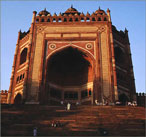
After breakfast at the hotel, depart by coach for Agra after visiting Fatehpur Sikri en route. Fatehpur Sikri was built in the mid 16th century by Emperor Akbar. Though the city was buil had to be abandoned after 15 years due to scarcity of water. Interestingly, Fathepur Sikri represents Akbar's secular, unifying and reconciliatory vision as the Emperor of India. The most important buildings in this vast complex are Buland Darwaza. Inside the fort is Diwan-i-Khas is a small double storied enclosure with a surprisingly innovative central pillar with heavy corbels that supports a balcony. Panch Mahal,a five-storey pavilion crowned with a domed chatri which overlooks the men's area. Jama Masjid and the white marble dargah of the Sufi saint Salim Chisti. 
Khwaja Shaikh Salim Chisti(1418-1572) was a greatly revered saint. Shaikh Salim was a Chishti saint who lived in the village of Sikri, as an ascetic. He came to imperial notice when he correctly predicted the birth of a childless Mughal emperor Akbar's son. He also looked after the emperor's wife who had come to live in his village during her pregnancy. It was to thank and honor this saint that Akbar, in 1571, established the palatial-religious complex of Fatehpur Sikri on the site of Shaikh Salim's village, making it his capital. In gratitude Akbar also named his son Salim who later succeeded his father and ruled as Jahangir. The saint died shortly after construction of the capital began. His tomb is of white marble, and is enclosed by the Jama Masjid. The entrance porch of his shrine is held up by unusual but extraordinary serpant-like supports. Inside the tomb is the saint's cenotaph, sheltered by a canopy decorated with mother-of-pearl. Salim Chisti's shrine is considered to be one of the best architectural accomplishments of the Mughals. Legend says that Emperor Akbar walked barefoot from Agra fort covering a distance of 20 miles to seek the saint's blessings. It is believed that offering prayers at Salim Chisti's shrine is wish fulfilling. There is also a ritual of tying a thread at the marble windows of this Dargah to fulfill the wishes. Lunch at Fatehpur Sikri Evening at leisure Overnight at Agra. |
DAY 9 |
Agra -> Delhi 205 Kms. 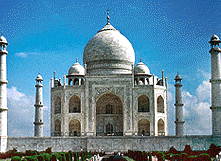
The Early Mughals rejected Delhi in favour of Agra to establish their capital. Though the Taj Mahal and the fort dominate Agra's built heritage, the quaint town is home to many Mughal royal and domestic buildings. European travellers have since the 16th century written about the city and its presently preserved and unpreserved buildings in great details. Visit Taj Mahal (1653 A.D) and Agra Fort (1573 A.D - mid 17th century) Taj Mahal one of the modern seven wonders of world was built in 1653 by the fifth Mughal emperor Shahjahan as a memorial to his wife Mumtaz Mahal by the bank of river Yamuna. After his wife's untimely death, Shahajahan vowed to have her mortal remains in a mausoleum that would be remembered by the world. His own remains are placed next to his wife's. The great monument took almost 22 years to complete. (TAJ MAHAL IS CLOSED ON FRIDAYS) Agra Fort The red sandstone fort as seen today was constructed by Emperor Akbar in 1573 and additions to the building continued till the time of his grandson Shahjahan. Agra Fort won the Aga Khan Award for Architecture in 2004 and is a UNESCO World Heritage Site. The palaces inside the fort are notable for their ingenious blending of Hindu and central Asian architectural styles. Important buildings are Diwan-i-Am (the hall of public audiences), the Diwan-i-Khas (the Hall of Private Audience), the Khas Palace (the private palace was used by emperor as a sleeping chamber), the Sheesh Mahal (palace of Mirrors), the Shah Jahani Mahal (Shahjahan's Palace), Jahangiri Mahal (Jahangir's Palace) and the Akbari Mahal (Akbar's palace) are the fascinating palaces inside the fort. From the rear of Diwan-i-Khas a door leads to Mussaman Burj, a two storey pavilion, where Shahjahan was imprisoned by his son Aurangzeb. The pavilion offers a beautiful view of the Taj Mahal. Leave agra in time to arrive Delhi - International airport. |
DAY 9 |
Final International Departure Late Evening or Mid-night to Board flight for back home. |